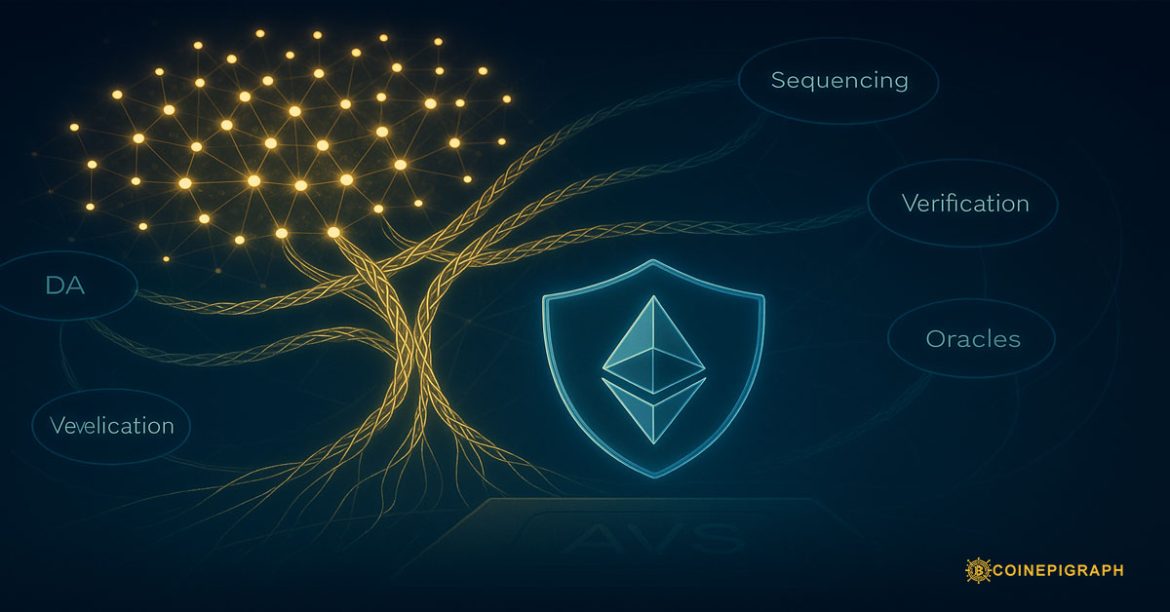CoinEpigraph Editorial Desk
Date: October 11, 2025
TL;DR
Restaking is turning Ethereum’s validator set into a reusable trust fabric. EigenLayer popularized the model by letting stakers “delegate” their economic security to Actively Validated Services (AVSs) like EigenDA, while new entrants such as Symbiotic push a chain-agnostic, permissionless approach. The upside is shared security and faster bootstraps for new networks; the risk is piling too many obligations onto ETH’s consensus—something Vitalik has cautioned against. The winners will be protocols that unlock real utility (DA, decentralized sequencing, verification, oracles) while keeping slashing risk, correlation risk, and governance creep in check.
The big unlock: reusable trust
For a decade, blockchains fought uphill to recruit enough validators and stake to be credibly neutral. Restaking flips that script. Instead of each network bootstrapping its own validator set from zero, a new service can “rent” Ethereum’s economic security by tapping staked ETH (or liquid staking tokens) that’s been opted into additional duties. EigenLayer operationalized this with a marketplace: restakers delegate to operators, operators run AVSs, and AVSs pay for security. EigenCloud
Why it matters: trust bootstraps are the most expensive part of launching new infrastructure—think data availability layers, decentralized sequencers, or verifiers for rollups. Restaking lets builders focus on product while piggybacking on ETH’s security. Done right, it compresses the time-to-neutrality for new networks. Stakin+1
What AVSs are shipping today
Data availability (DA): EigenDA is the flagship AVS—high-throughput DA designed for rollups. EigenLayer reports multi-million ETH securing EigenDA as of 2025, aligning incentives by paying restakers for DA work while keeping rollup fees competitive.
Decentralized sequencing + state verification: The “restaked rollups” concept bundles AVSs for sequencing, correctness proofs, and faster economic finality, giving app-specific rollups a path to more credible neutrality without handing keys to a single sequencer. AltLayer helped popularize this framing.
Oracles & other services: The AVS model generalizes to oracles, policy engines, and shared services for pre-transaction computation—anything where crypto-economic security and active validation improve guarantees. Aggregators now track dozens of AVSs across categories.
The new competitive set: EigenLayer vs. Symbiotic (and friends)
EigenLayer’s lead is clear in mindshare and deployed AVSs, but 2024–2025 brought real competition. Symbiotic launched a permissionless, asset-agnostic restaking layer with early caps and phased rollout, then crossed ten-figure TVL with full slashing support. Its philosophy: make restaking universal—beyond just ETH and LSTs—while keeping the coordination layer thin.
Why this matters for builders:
- Design surface area: EigenLayer gives you ETH-centric security and a mature operator marketplace. Symbiotic offers multi-asset collateral and modularity from day one. Different constraints yield different threat models, incentives, and bootstraps.
- Distribution: EigenLayer’s early AVS ecosystem (EigenDA et al.) means integrations and tooling come “pre-warmed.” Symbiotic’s neutrality aims to court non-ETH ecosystems and exotic collateral.
- Risk posture: Slashing semantics, rehypothecation rules, and correlation exposure vary by protocol. For sophisticated treasuries, these details drive expected value far more than headline APRs. (Symbiotic’s emphasis on immediate slashing was a clear signal to professionalize risk.)
The risk ledger: what could break—and how to price it
Vitalik’s standing caution is simple: don’t overload Ethereum’s consensus with duties that lean on social recovery or force the base layer to adjudicate external failures. The more we entangle validator identity and slashing across many services, the higher the chance of contagion, correlated failures, and governance crises.
Key risks to model before you restake:
- Correlation & cascade risk. Multiple AVSs relying on similar operators and clients can create synchronized failure modes. A single client bug or config error propagates into multi-domain slashings. Price this like portfolio tail risk—not average APR. (Operators and AVSs with heterogeneous stacks deserve a premium.)
- Slashing semantics & adjudication. “What exactly gets you slashed?” is no longer one answer. Each AVS defines offenses and evidence. If disputes escalate into subjective human judgment, you’re importing governance risk. Demand crisp specifications and on-chain, objective fault proofs wherever possible.
- Liquidity layering & exit friction. Liquid restaking adds wrappers on wrappers. In stress, pecking orders appear: some wrappers de-peg, others halt redemptions, and exit queues collide. If you’re taking LRTs as treasury assets, haircut them like mezzanine debt, not cash.
- Economic dilution. Shared security is only as strong as incentives. If an AVS underpays relative to the risk it imposes, rational operators free-ride or churn. Sustainable rewards matter more than attention-stage emissions.
Where this goes next
Modular stacks become “service-first.” Instead of shipping monolithic L2s, teams will assemble stacks around three paid primitives: DA, sequencing, and verification. AVSs compete on latency, cost, and failure isolation—with restaking as the demand router.
Cross-ecosystem security. Symbiotic’s universal stance (ERC-20s, LP tokens, stablecoins) previews a future where Bitcoin L2s, appchains, and oracle networks all tap a common security marketplace. Expect bridges, oracles, and settlement layers to negotiate multi-asset slash conditions.
Operator professionalization. As slashing gets real and duties get specialized (e.g., DA vs. sequencing), we’ll see “AVS-native” operators with distinct SRE playbooks, isolated infra per AVS, and insurance markets that finally underwrite objective faults.
Policy surface area. The more “bank-like” restaking looks (rehypothecation, layered yields, complex risk), the more it attracts regulatory curiosity. Protocols that keep duties narrowly scoped and failure-containment clean will be easier to explain—and to list. (We’ll track this as it evolves.) Inference based on current trends and prior policy responses to yield-bearing wrappers.
How builders should decide (a practical rubric)
- Define the job to be done. If you’re a rollup, you likely need DA + sequencing + verification in that order. If you’re an oracle or MEV-aware service, you need different liveness/latency guarantees. Map those to AVSs that publish hard SLOs and blame-free postmortems.
- Interrogate slashing objectively. Prefer AVSs with crisp, on-chain fault proofs and minimal social adjudication. Ask for historical drills and public slashing dry-runs with test operators.
- Diversify operator sets. Avoid single-client, single-cloud, single-region exposure. Pay for heterogeneity; it’s cheaper than a correlated slashing event.
- Treat LRTs as risk assets. If you hold liquid restaked tokens on treasury, apply haircuts in stress scenarios and pre-commit to redemption waterfalls.
- Prefer sustainable emissions. If rewards don’t line up with well-specified duties, you’re subsidizing someone else’s risk. Walk.
Bottom line
Restaking is Ethereum’s most powerful new coordination primitive since rollups—an exportable trust layer that lets new networks stand up with the credibility of mature collateral. The frontier now is governance and risk: making sure the base layer doesn’t inherit obligations it can’t—or shouldn’t—enforce. The teams that win will be the ones that do the boring work: crisp slashing, heterogeneous operators, lean duties, and transparent postmortems. Reusable trust is here. Responsible trust is the moat.
At Coinepigraph, we pride ourselves on delivering cryptocurrency news with the utmost journalistic integrity and professionalism. Our dedicated team is committed to providing accurate, insightful, and unbiased reporting to keep you informed in the ever-evolving crypto landscape. Stay tuned as we expand our coverage to include new sections and thought-provoking op-eds, ensuring Coinepigraph remains your trusted source for all things crypto. -Ian Mayzberg Editor-in-Chief
The team at CoinEpigraph.com is committed to independent analysis and a clear view of the evolving digital asset order.
To help sustain our work and editorial independence, we would appreciate your support of any amount of Bitcoin/Satoshi to this address below: 3NM7AAdxxaJ7jUhZ2nyfgcheWkrquvCzRm
and through our Support Page.
🔍 Disclaimer: CoinEpigraph is for entertainment and information, not investment advice. Markets are volatile — always conduct your own research.
COINEPIGRAPH does not offer investment advice. Always conduct thorough research before making any market decisions regarding cryptocurrency or other asset classes. Past performance is not a reliable indicator of future outcomes. All rights reserved 2024-2025.




